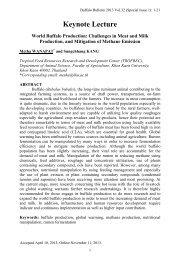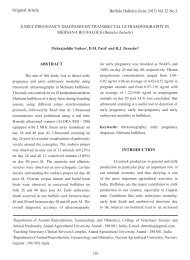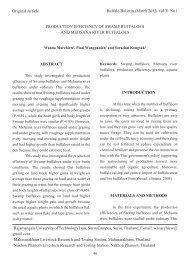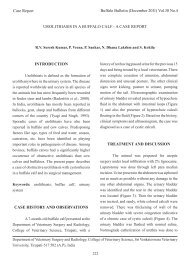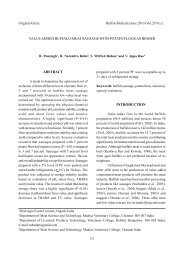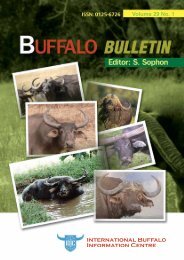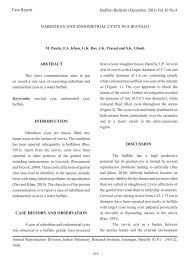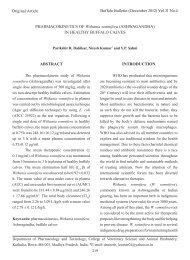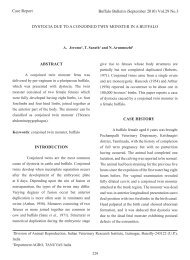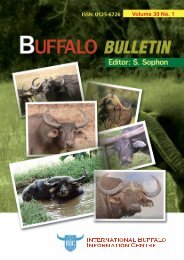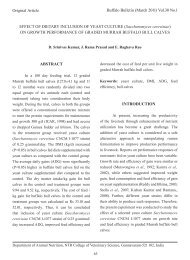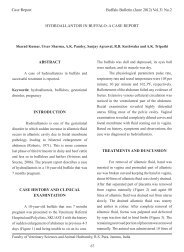Buffalo Bulletin (December 2009) Vol.28 No.4 PATELLAR ...
Buffalo Bulletin (December 2009) Vol.28 No.4 PATELLAR ...
Buffalo Bulletin (December 2009) Vol.28 No.4 PATELLAR ...
You also want an ePaper? Increase the reach of your titles
YUMPU automatically turns print PDFs into web optimized ePapers that Google loves.
<strong>Buffalo</strong> <strong>Bulletin</strong> (<strong>December</strong> <strong>2009</strong>) <strong>Vol.28</strong> <strong>No.4</strong>RESULTS AND DISCUSSIONAll the animals fully recovered within oneweek of the iodine injection treatment. Duringobservation after one week none of the animalsshowed any sign of “Stringhalt” when getting upand walking thereafter. As reported by the ownersof the animals there was slight swelling at theinjection site which subsided on its own in 2-3 days;otherwise, there was no untoward reaction.Generally, animals suffering from stringhaltare relieved of the ailment by patellar desmotomy.However, this procedure is not free from mishaps.The procedure involves invasive surgery and needsthe services of an expert for the location of medianpatellar ligament in buffalo due to its thick skin (Singh,1979; Baird et al., 1993). Moreover, after theoperation there are chances of sepsis which needto be taken care of by daily dressings and antibioticinjections and visits of a veterinarian, which doesincur quite a cost and involves labour and time. Ithas been usually observed that after patellardesmotomy of one limb the other hind limb alsodevelops this problem in a short time after theoperation, which again needs the same procedureto be repeated. Hence, to avoid such complicationsthe injection of iodine was chosen, which is cheap,safe and permanent. Vaghan (1960) recommended5-10 ml of mild solution of iodine injection, which inour experience, lower doses (5 ml) are least effectiveand higher doses (10 ml) are injurious to thesurrounding tissues.The etiology of stringhalt still eludesscientists. However, there are certain opinions/hypotheses laid down by research workers whichinvolve varied factors, such as genetics,demographic, involvement of nervous system,nutritional- involving some minerals and poisoningdue to certain weeds infected by some fungus. Inour opinion there are imbalances of certain mineralssuch as calcium/phosphorus, copper/molybdenum/zinc and sulphate etc., at least in buffaloes. We haveobserved that buffaloes either in late pregnancy orearly lactation are commonly affected by thisailment. Moreover, it is the areas which are knownfor mineral imbalances in forages, soil and water inwich affected buffaloes are mostly encountered.Dhillon et al. (1972) reported that buffaloes in latepregnancy and early lactation suffer frommolybdenum-induced phosphorus deficiencyhaemoglobinurea in such areas in Punjab. Duringlate pregnancy and early lactation, these animalsrequire more calcium and phosphorus for thedeveloping fetus and milk secretion and are likely tosuffer from shortage of these elements. There maybe excessive exostosis of tibial tubrosoty, whichmight hinder the normal slipping of the ligamentduring walking and resulting in stringhalt. Theseauthors have also reported bone deformities inbuffalo-calves in these areas ( Dhillon et al., 1993).Similar observations have been made by Silvaa etal. (2004).To settle the cause of stringhalt inbuffaloes, well planned experimental studies undercontrolled conditions are warranted and effectivecontrol measures should be found for this malady.REFERENCESAraujo, J.A.S., B. Curcio, J. Alda, R.M.T. Medeirosand F. Riet-Correa. 2008. Stringhalt inBrazilian horses caused by Hypochaerisradicata. Toxicon, 52: 190-193.Baird, A.N., K.L. Angel, H.D. Moll, D.F. Wolfe,D.L. Morris, R.D. Welch, R.N. Hooper andJ.G. Wenzel. 1993. Upward fixation of thepatella in cattle: 38 cases (1984-1990).JAVMA., 202: 434-436.Cahill J.I., B.E. Goulden and H.G. Pearce. 1985. Areview and some observations on Stringhalt.N. Z. Vet. J., 33: 101-104.Duzgun, O. 2005. A retrospective study: Evaluationof patellar luxation cases of cats. Turk. J. Vet.Anim. Sci., 20: 279-283.Dhillon, K.S., J. Singh and R.S. Bajwa. 1972.Treatment of haemoglobinurea due tomolybdenum-induced phosphorus deficiencyin buffaloes. Indian J. Anim. Sci., 42: 996-998.Dhillon, K.S., H.S. Sandhu, T.J. Singh, B.S. Gill, J.Singh and R.S. Brar. 1993. Chronic*Continued to page 197169
<strong>Buffalo</strong> <strong>Bulletin</strong> (<strong>December</strong> <strong>2009</strong>) <strong>Vol.28</strong> <strong>No.4</strong>using HPLC. J. Agr. Food Chem., 41: 303-307.Jaiswal, A., V. Kumar Parihar and M. SudheerKumar. 2005. 5-aminosalicylic acid reversesendosulfan induced testicular toxicity in malerats. Mutat. Res.-Genet. Toxicol. E. M.,585(1-2): 50-59Jill, M. 2003. Indian children in pesticide controversy-The area has a large number children withdeformed limbs. Website: http://news.bbc.co.ukMeena, Menon. 2003. Forget colas, what about thepesticides in your wheat, water andbreastmilk?, In Infochange toxic tours-XII,New Delhi. Website: http://www.infochangeindia.org/toxictours12.jspMOHFW. 2004. Pesticides and GoodAgricultural Practices. Ministry of Healthand Family Welfare, India. Website: http://mohfw.nic.in/pfa.htmNagappa, K. 2005. Studies on the pesticide(chlorpyrifos and endosulfan) residues inwater, milk and feed/fodder using highperformance liquid chromatography.M.V.sc. Thesis, G.B.P.U.A. & T., Pantnagar.Oliveira Ribeiro, C.A., Y. Vollaire, A. Sanchez-Chardiand H. Roche. 2005. Bioaccumulation and theeffects of organochlorine pesticides, PAH andheavy metals in the Eel (anguilla anguilla) atthe Camargue Nature Reserve, France.Aquat. Toxicol., 74(1): 53-69.Pradeep Kumar, S.P. Singh, A.H. Ahmad and V.D.P.Rao. 2008. Simultaneous detection ofendosulfan and chlorpyrifos residues in buffalomeat using high performance liquidchromatography. Analytical Chemistry: AnIndian Journal, 7(2): 103-109.Ranjhan, S.K. 2005. Problems and prospects in safeand quality meat production, p. 54-57. InProceedings of National Seminar on FoodQuality and Safety Standards ofAgricultural Raw and Processed Produce,New Delhi, India.Roy, B.K. 2001. Toxicity caused by food additivesand preservatives, p. 537-545. In Roy, B.K.Veterinary Pharmacology and Toxicology.Kalyani publishers, New Delhi.Simon, Ao. 2003. Detection and quantification ofpesticide residues in pork. M.V.sc. Thesis,G.B.P.U.A. & T., Pantnagar.Taneja, R. 2000. Detection and quantification ofpesticide residues in raw and cooked cattleand buffalo meat. M.V.sc. Thesis,G.B.P.U.A. & T., Pantnagar.Websites: Codex@fao.org, http://www.foodstandards.gov.au*Continued from page 169molybdenosis in buffaloes. Indian J. Anim.Sci., 63: 1072-1074.Krishnamurthy, D. and R.P.S. Tyagy. 1978.Characteristics of synovial fluid and blood seraof cattle, buffalo and camels in health andwhen affected with upward fixation of patella.Indian Vet. J., 55: 567-571.Shettko, D.L. and S.S. Trostle. 2000. Diagnosis andsurgical repair of patellar luxation in a flockof sheep. J. Vet. Med. Asso., 216: 564-566.Silvaa, LAFd, M.C.S. Floravanti, D. Eurides, I.B.Atayde, C.A. Silva, O.C. Silva and B.R.Trindade. 2004. Dorsal patellar fixation incattle: Desmotomy on lateral recumbency. Isr.J. Vet. Med., 59: 43-46.Singh, K.B. 1979. Chronic pseudo luxation of patellain bovines, some observations. Indian Vet. J.,56: 704-706.Takahashi, T., M. Kitamura, Y. Endo, Y. Endo, D.Eto, O. Aoki, R. Kusunose, T. Yoshihara andM. Kai. 2002. An outbreak of stringhaltresembling Australian stringhalt in Japan. J.Equine Sci., 13: 93-100.Vaghan, L.C. 1960. Orthopaedic surgery in farmanimals. Vet. Rec., 72: 399-403.197



